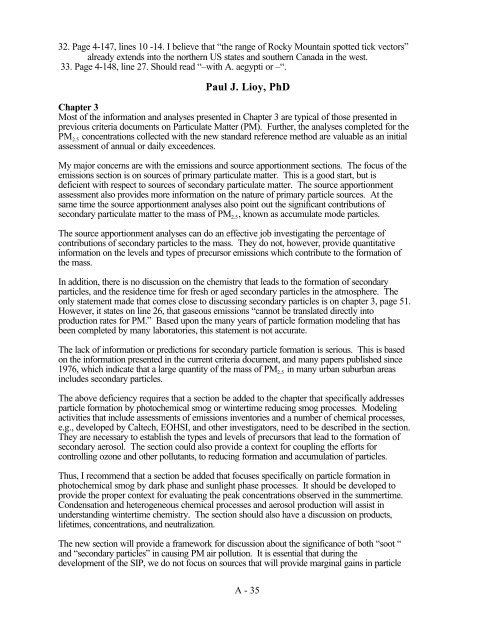Review of the Air Quality Criteria Document for Particulate Matter
Review of the Air Quality Criteria Document for Particulate Matter
Review of the Air Quality Criteria Document for Particulate Matter
- No tags were found...
Create successful ePaper yourself
Turn your PDF publications into a flip-book with our unique Google optimized e-Paper software.
32. Page 4-147, lines 10 -14. I believe that “<strong>the</strong> range <strong>of</strong> Rocky Mountain spotted tick vectors”already extends into <strong>the</strong> nor<strong>the</strong>rn US states and sou<strong>the</strong>rn Canada in <strong>the</strong> west.33. Page 4-148, line 27. Should read “–with A. aegypti or –“.Paul J. Lioy, PhDChapter 3Most <strong>of</strong> <strong>the</strong> in<strong>for</strong>mation and analyses presented in Chapter 3 are typical <strong>of</strong> those presented inprevious criteria documents on <strong>Particulate</strong> <strong>Matter</strong> (PM). Fur<strong>the</strong>r, <strong>the</strong> analyses completed <strong>for</strong> <strong>the</strong>PM 2.5 concentrations collected with <strong>the</strong> new standard reference method are valuable as an initialassessment <strong>of</strong> annual or daily exceedences.My major concerns are with <strong>the</strong> emissions and source apportionment sections. The focus <strong>of</strong> <strong>the</strong>emissions section is on sources <strong>of</strong> primary particulate matter. This is a good start, but isdeficient with respect to sources <strong>of</strong> secondary particulate matter. The source apportionmentassessment also provides more in<strong>for</strong>mation on <strong>the</strong> nature <strong>of</strong> primary particle sources. At <strong>the</strong>same time <strong>the</strong> source apportionment analyses also point out <strong>the</strong> significant contributions <strong>of</strong>secondary particulate matter to <strong>the</strong> mass <strong>of</strong> PM 2.5 , known as accumulate mode particles.The source apportionment analyses can do an effective job investigating <strong>the</strong> percentage <strong>of</strong>contributions <strong>of</strong> secondary particles to <strong>the</strong> mass. They do not, however, provide quantitativein<strong>for</strong>mation on <strong>the</strong> levels and types <strong>of</strong> precursor emissions which contribute to <strong>the</strong> <strong>for</strong>mation <strong>of</strong><strong>the</strong> mass.In addition, <strong>the</strong>re is no discussion on <strong>the</strong> chemistry that leads to <strong>the</strong> <strong>for</strong>mation <strong>of</strong> secondaryparticles, and <strong>the</strong> residence time <strong>for</strong> fresh or aged secondary particles in <strong>the</strong> atmosphere. Theonly statement made that comes close to discussing secondary particles is on chapter 3, page 51.However, it states on line 26, that gaseous emissions “cannot be translated directly intoproduction rates <strong>for</strong> PM.” Based upon <strong>the</strong> many years <strong>of</strong> particle <strong>for</strong>mation modeling that hasbeen completed by many laboratories, this statement is not accurate.The lack <strong>of</strong> in<strong>for</strong>mation or predictions <strong>for</strong> secondary particle <strong>for</strong>mation is serious. This is basedon <strong>the</strong> in<strong>for</strong>mation presented in <strong>the</strong> current criteria document, and many papers published since1976, which indicate that a large quantity <strong>of</strong> <strong>the</strong> mass <strong>of</strong> PM 2.5 in many urban suburban areasincludes secondary particles.The above deficiency requires that a section be added to <strong>the</strong> chapter that specifically addressesparticle <strong>for</strong>mation by photochemical smog or wintertime reducing smog processes. Modelingactivities that include assessments <strong>of</strong> emissions inventories and a number <strong>of</strong> chemical processes,e.g., developed by Caltech, EOHSI, and o<strong>the</strong>r investigators, need to be described in <strong>the</strong> section.They are necessary to establish <strong>the</strong> types and levels <strong>of</strong> precursors that lead to <strong>the</strong> <strong>for</strong>mation <strong>of</strong>secondary aerosol. The section could also provide a context <strong>for</strong> coupling <strong>the</strong> ef<strong>for</strong>ts <strong>for</strong>controlling ozone and o<strong>the</strong>r pollutants, to reducing <strong>for</strong>mation and accumulation <strong>of</strong> particles.Thus, I recommend that a section be added that focuses specifically on particle <strong>for</strong>mation inphotochemical smog by dark phase and sunlight phase processes. It should be developed toprovide <strong>the</strong> proper context <strong>for</strong> evaluating <strong>the</strong> peak concentrations observed in <strong>the</strong> summertime.Condensation and heterogeneous chemical processes and aerosol production will assist inunderstanding wintertime chemistry. The section should also have a discussion on products,lifetimes, concentrations, and neutralization.The new section will provide a framework <strong>for</strong> discussion about <strong>the</strong> significance <strong>of</strong> both “soot “and “secondary particles” in causing PM air pollution. It is essential that during <strong>the</strong>development <strong>of</strong> <strong>the</strong> SIP, we do not focus on sources that will provide marginal gains in particleA - 35
















